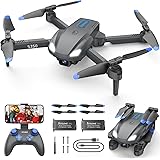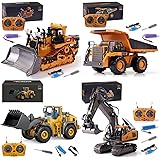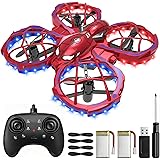Could the future of aerial transportation and sophisticated drone technology be emerging from university workshops right now? Watching the accompanying video, which showcases the remarkable VTOL quadplane designed by Verna students, offers a compelling glimpse into this exciting possibility. Their innovative approach to VTOL quadplane development signals a significant leap forward in drone technology and engineering.
This impressive student project highlights the powerful fusion of vertical take-off capabilities with efficient fixed-wing flight, pushing the boundaries of what unmanned aerial vehicles (UAVs) can achieve. Such groundbreaking work not only inspires future engineers but also addresses real-world challenges with ingenious solutions. Understanding the complexities behind this type of drone design reveals the sheer ingenuity involved in transforming theoretical knowledge into a tangible, high-performance flying machine.
What Exactly is a VTOL Quadplane? Decoding this Innovative Drone Design
A VTOL quadplane stands as a testament to engineering versatility, brilliantly merging two distinct flight philosophies into a singular, highly adaptable aircraft. Imagine a vehicle that possesses the precise hovering capabilities of a helicopter, capable of vertical take-off and landing even in confined spaces, yet can also transform mid-flight to glide efficiently like a conventional airplane. This is precisely the operational magic of a VTOL quadplane, making it far more dynamic than traditional drone models.
Unlike standard multirotor drones, which primarily rely on multiple propellers for lift and propulsion in all flight phases, a quadplane integrates fixed wings into its structure. This design allows it to transition from vertical flight, powered by its quadrotor configuration, to horizontal flight where the wings generate aerodynamic lift. This strategic blend offers substantial advantages in terms of speed, range, and energy efficiency, overcoming many limitations faced by purely rotary-wing or fixed-wing aircraft.
The Hybrid Advantage: Efficiency Meets Versatility
The primary benefit of this hybrid design lies in its exceptional operational flexibility. Traditional multirotor drones, while excellent for precision hovering and confined-area operations, often struggle with speed and endurance due to their inherent aerodynamic drag. Conversely, fixed-wing aircraft excel in sustained, high-speed flight but require runways for take-off and landing, limiting their deployment options. A VTOL quadplane elegantly circumvents these drawbacks, offering the best of both worlds.
Consider the energy consumption: hovering flight demands significant power, which quickly depletes battery life in multirotors. By transitioning to fixed-wing flight, a quadplane can utilize its wings to generate lift, allowing its propellers to focus solely on forward thrust, thereby conserving energy. This remarkable efficiency translates directly into extended flight times and greater operational ranges, making these innovative drones suitable for a wider array of demanding missions. Furthermore, the ability to operate from virtually any location, regardless of runway availability, dramatically expands their utility for various applications.
The Engineering Marvel: Navigating Design Challenges in VTOL Drones
Developing an innovative VTOL quadplane, such as the one conceptualized by the talented Verna students, involves grappling with a sophisticated array of engineering challenges. It is akin to orchestrating a complex ballet where every component must perform flawlessly in harmony. Engineers must address intricate aerodynamic considerations, ensuring stability and control across diverse flight regimes—from stationary hover to high-speed forward flight and, critically, the transition between these modes. This seamless shift requires precise calibration and robust system integration.
Furthermore, the design must account for power management, structural integrity, and advanced control algorithms. These systems are essential for managing the dynamic forces at play during take-off, landing, and especially during the critical transition phase. Achieving an optimal balance between payload capacity, flight duration, and overall aircraft weight is a perpetual puzzle, demanding meticulous material selection and ingenious structural design.
Powering Flight: Propulsion Systems and Battery Innovations
The propulsion system of a VTOL quadplane represents a marvel of modern engineering, directly influencing its performance and endurance. Most contemporary VTOL designs, including many sophisticated drone technology applications, rely on electric motors and high-density battery packs. The challenge lies in providing sufficient power for vertical lift during take-off and landing, which demands intense energy output, while also efficiently propelling the aircraft during forward flight.
Innovations in battery technology, such as solid-state batteries or advanced lithium-ion cells, are constantly pushing the boundaries of what is possible, offering greater energy density and faster charging capabilities. Moreover, the efficiency of electric motors has significantly improved, allowing for lighter, yet more powerful, propulsion units. These advancements are crucial for extending flight times and increasing the practical utility of VTOL drones, transforming them from mere concepts into reliable workhorses for various industries.
Mastering the Skies: Control Systems and Autonomous Capabilities
At the heart of any advanced VTOL quadplane lies its sophisticated control system, functioning much like the nervous system of the aircraft. This complex network integrates data from various sensors—gyroscopes, accelerometers, GPS, and altimeters—to maintain stability, execute maneuvers, and manage the critical flight transitions. The flight controller acts as the brain, processing this incoming information in real-time to adjust motor speeds and control surfaces with incredible precision.
Beyond basic flight stabilization, modern VTOL drones are increasingly equipped with advanced autonomous capabilities. These include features like automated mission planning, obstacle avoidance, and even self-landing protocols. Such autonomy reduces the pilot’s workload and significantly enhances operational safety and efficiency, particularly for complex missions. The development of robust algorithms and reliable sensor fusion techniques remains a pivotal area of research, continually refining the capabilities of these remarkable machines.
The Impact of Student Innovation: Fueling the Future of Flight
The project undertaken by the Verna students exemplifies the profound impact that academic initiatives have on the trajectory of technological advancement, especially within fields like drone technology and aerospace engineering. Student projects are not merely academic exercises; they serve as vital incubators for cutting-edge ideas and future industry leaders. These endeavors provide invaluable hands-on experience, allowing students to apply theoretical knowledge to tangible, complex challenges.
Furthermore, such innovation often brings fresh perspectives, unburdened by conventional industry constraints. Students are frequently more willing to experiment with unconventional designs and novel solutions, leading to truly innovative breakthroughs. The passion and ingenuity demonstrated in projects like this VTOL quadplane are foundational to continuous progress, ensuring a vibrant pipeline of talent and ideas that will shape the next generation of aerial mobility solutions. This early exposure to real-world problem-solving is unparalleled.
From Classroom to Clouds: The Learning Curve in Drone Development
The journey of developing a sophisticated aircraft like a VTOL quadplane from concept to a functioning prototype represents an immense learning curve for any student team. It requires a multidisciplinary approach, blending knowledge from aerodynamics, electrical engineering, software development, and mechanical design. Students learn not only the technical intricacies but also crucial soft skills, such as teamwork, project management, and problem-solving under pressure.
Every challenge encountered, from unexpected aerodynamic instabilities to power system glitches, offers a valuable opportunity for learning and refinement. The iterative process of design, build, test, and revise is fundamental to engineering education. Through this practical application, students gain a deep, intuitive understanding of complex systems, preparing them to tackle even greater challenges in their professional careers. This hands-on experience is truly irreplaceable in fostering capable engineers.
Beyond the Horizon: Applications and Future Potential of VTOL Quadplanes
The versatility and efficiency inherent in VTOL quadplane designs position them as powerful tools across a myriad of future applications. Imagine these advanced drones revolutionizing industries far beyond current capabilities. In logistics, they could enable rapid, autonomous delivery of packages to remote or congested urban areas, overcoming traffic bottlenecks with unparalleled speed. For infrastructure inspection, quadplanes can survey vast networks of power lines, pipelines, or bridges with greater range and endurance than traditional multirotors, identifying issues far more efficiently.
Furthermore, their hybrid flight characteristics make them ideal for critical public safety roles. In search and rescue operations, a VTOL quadplane could quickly cover large areas, identify distressed individuals, and even deliver essential supplies to hard-to-reach locations. Environmentally, these drones could monitor wildlife, track deforestation, or assess disaster zones, providing vital data with minimal disturbance. The potential for these innovative drones to reshape various sectors is immense, acting like an aerial Swiss Army knife for the modern age.
Shaping Urban Air Mobility with Advanced Drone Technology
One of the most exciting and transformative applications for VTOL quadplane technology lies within the burgeoning field of urban air mobility (UAM). As cities become increasingly crowded and ground transportation networks strain under demand, the concept of aerial vehicles for passenger and cargo transport gains significant traction. VTOL designs, with their ability to take off and land without runways, are perfectly suited for urban environments, where space is a premium. They can operate from rooftops, parking garages, or dedicated vertiports, seamlessly integrating into existing urban infrastructure.
This innovative drone technology could facilitate on-demand air taxis, connecting distant parts of a city or its surrounding suburbs with unprecedented speed. Moreover, dedicated cargo drone technology networks could alleviate road congestion by moving goods through the air, particularly for time-sensitive deliveries. The Verna students’ project contributes to this vision by exploring the fundamental principles and practical designs required for such future systems, helping to pave the way for a new era of urban transportation.
Staying Ahead in Drone Technology: A Dynamic and Evolving Field
The realm of drone technology is characterized by relentless innovation and rapid evolution, making it an incredibly dynamic field where continuous learning is paramount. Projects like the VTOL quadplane designed by Verna students serve as powerful indicators of where the industry is heading. Their work highlights the constant push for greater efficiency, increased autonomy, and expanded operational capabilities that define modern UAV development.
To remain at the forefront, engineers, hobbyists, and industry professionals alike must continuously engage with new research, embrace emerging technologies, and adapt to evolving regulatory landscapes. The successful development of a complex system like a VTOL quadplane requires an integrated understanding of diverse engineering disciplines, underscoring the importance of interdisciplinary collaboration. This spirit of innovation, exemplified by student projects, ensures that the future of aerial mobility will continue to soar to new heights, driven by creativity and cutting-edge engineering. This continuous pursuit of excellence is what propels the entire drone design ecosystem forward.











